
Castor is the second-brightest object in the zodiac constellation of Gemini. It has the Bayer designation α Geminorum, which is Latinised to Alpha Geminorum and abbreviated Alpha Gem or α Gem. With an apparent visual magnitude of 1.58, it is one of the brightest stars in the night sky. Castor appears singular to the naked eye, but it is actually a sextuple star system organized into three binary pairs. Although it is the 'α' (alpha) member of the constellation, it is half a magnitude fainter than 'β' (beta) Geminorum, Pollux.
12 Ophiuchi is a variable star in the constellation Ophiuchus. No companions have yet been detected in orbit around this star, and it remains uncertain whether or not it possesses a dust ring.
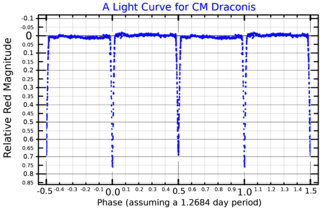
CM Draconis is an eclipsing binary star system 48.5 light-years away in the constellation of Draco. The system consists of two nearly identical red dwarf stars that orbit each other with a period of 1.268 days and a separation of 2.6 million kilometres. Along with two stars in the triple system KOI-126, the stars in CM Draconis are among the lightest stars with precisely measured masses and radii. Consequently, the system plays an important role in testing stellar structure models for very low mass stars. These comparisons find that models underpredict the stellar radii by approximately 5%. This is attributed to consequences of the stars' strong magnetic activity.
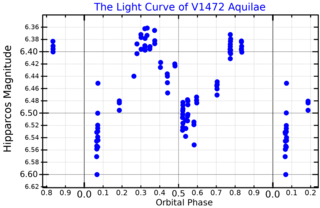
V1472 Aquilae is a triple star system in the equatorial constellation of Aquila. It is a variable star that ranges in brightness from 6.36 down to 6.60. The system is located at a distance of approximately 780 light years from the Sun based on parallax. It is a high-velocity star system with a radial velocity of −112 km/s.

Iota Herculis is a fourth-magnitude variable star system in the constellation Hercules, consisting of at least four stars all about 139 parsecs away. The brightest is a β Cephei variable, a pulsating star.

Theta Draconis, a name Latinized from θ Draconis, is a binary star system in the northern circumpolar constellation of Draco. It is faintly visible to the naked eye at night with an apparent visual magnitude of 4.12. Parallax measurements place it at an estimated distance of 68.6 light-years from the Sun, and it is drifting closer with a radial velocity of −8 km/s. It has a relatively high proper motion, traversing the celestial sphere at the rate of 0.464″ per year. O. J. Eggen included this star as a member of the NGC 1901 supercluster based on its space motion.

Phi Draconis is a fourth-magnitude variable star in the constellation Draco. It has the Flamsteed designation 43 Draconis. It is also a triple star system where the brightest component is a chemically peculiar Ap star.
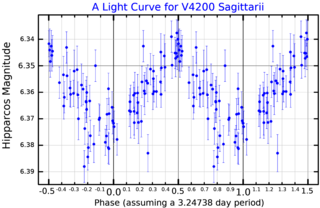
HR 7578 is a binary star in the constellation of Sagittarius. Their combined apparent magnitude is 6.18. Parallax measurements by the Gaia spacecraft put the system at 46.01 light-years away, making this a nearby system.
Upsilon Draconis is a binary star system in the northern circumpolar constellation of Draco. It is faintly visible to the naked eye with an apparent visual magnitude of 4.83. Based upon an annual parallax shift of 9.48 mas as measured from Earth, it is located around 340 light years from the Sun. At that distance, the visual magnitude of the star is diminished by an extinction factor of 0.02 due to interstellar dust.
39 Draconis is a wide binary star system in the northern circumpolar constellation of Draco. It has the Bayer designation b Draconis, while 39 Draconis is the Flamsteed designation. This system is visible to the naked eye as a dim, white-hued point of light with an apparent visual magnitude of 5.0. Parallax measurements made by the Hipparcos spacecraft put it at a distance of 184 light-years, or 56 parsecs away from the Sun. The system is moving closer to the Earth with a heliocentric radial velocity of -24.5 km/s.
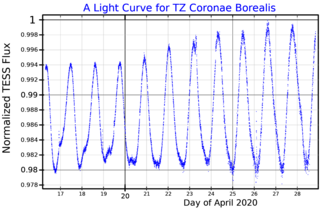
Sigma Coronae Borealis is a star system in the constellation of Corona Borealis. It is a quintuple star system containing three sunlike main-sequence stars and two other low-mass stars. The combined visual magnitude is 5.3 and the system lies 74 light years from Earth. σ CrB A is the variable star TZ Coronae Borealis.
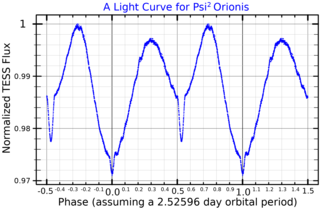
Psi2 Orionis a binary star system in the equatorial constellation of Orion. It has an apparent visual magnitude of 4.6, indicating that it is visible to the naked eye. Based upon an annual parallax shift of 2.87 mass, it is roughly 1,100 light years distant from the Sun.
Phi Phoenicis, Latinized from φ Phoenicis, is a binary star system in the southern constellation of Phoenix. It is faintly visible to the naked eye with an apparent visual magnitude of 5.1. Based upon an annual parallax shift of 10.185 mas as seen from Earth, it is located approximately 320 light years from the Sun. It is moving away with a heliocentric radial velocity of 10.4 km/s.
HD 163840 is a binary star system in the northern constellation of Hercules. It has a combined apparent visual magnitude of 6.45, which falls just below the brightness level that is visible to the naked eye for people with normal eyesight. An annual parallax shift of 35.40 mas provides a distance estimate of about 92 light years. The system is moving closer to the Sun with a radial velocity of −33 km/s. In about 769,000 years, it will make perihelion at a separation of around 27.2 ly (8.33 pc).
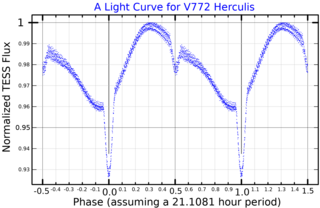
HD 165590 is a quintuple system dominated by the binary Algol variable star known as V772 Herculis. The system lies in the constellation of Hercules about 123 light years from the Sun, and is suspected to be a part of the Pleiades moving group.
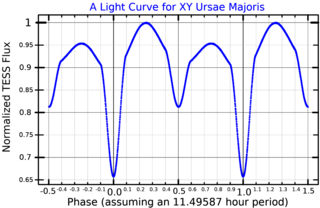
XY Ursae Majoris is a short period binary star system in the northern circumpolar constellation of Ursa Major. It is an eclipsing binary with a baseline apparent visual magnitude of 9.50. The system is located at a distance of 221.5 light years from the Sun based on parallax measurements, but is drifting closer with a radial velocity of −10 km/s. It has a relatively high proper motion, traversing the celestial sphere at the angular rate of 0.191″·yr−1.
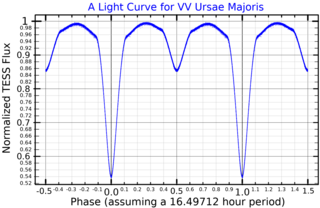
VV Ursae Majoris is a binary star system in the northern circumpolar constellation of Ursa Major, abbreviated VV UMa. It is a variable star system with a brightness that cycles around an apparent visual magnitude of 10.19, making it too faint to be visible to the naked eye. The system is located at a distance of approximately 1,500 light years based on parallax measurements.
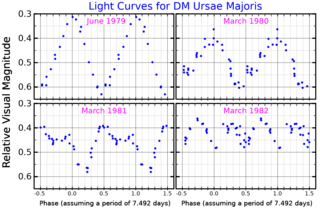
DM Ursae Majoris is a binary star system in the northern circumpolar constellation of Ursa Major, abbreviated DM UMa. It is sometimes identified by the Bonner Durchmusterung catalogue designation BD +61 1211; DM UMa is the variable star designation. The system has a combined apparent visual magnitude of 9.29, which is too faint to be visible to the naked eye. Based on parallax measurements, the system is located at a distance of approximately 606 light years from the Sun, but it is drifting closer with a heliocentric radial velocity of −7 km/s.
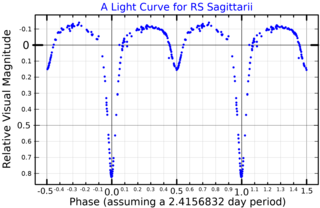
RS Sagittarii is an eclipsing binary star system in the southern constellation of Sagittarius, abbreviated RS Sgr. It is a double-lined spectroscopic binary with an orbital period of 2.416 days, indicating that the components are too close to each other to be individually resolved. The system has a combined apparent visual magnitude of 6.01, which is bright enough to be faintly visible to the naked eye. During the primary eclipse the brightness drops to magnitude 6.97, while the secondary eclipse is of magnitude 6.28. The distance to this system is approximately 1,420 light years based on parallax measurements.
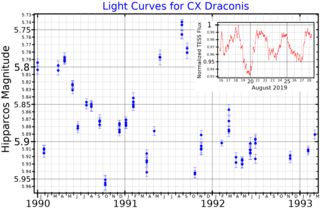
CX Draconis is an interacting binary star system in the northern constellation of Draco, abbreviated CX Dra. It has the designation HD 174237 in the Henry Draper Catalogue; CX Draconis is the variable star designation. This is a double-lined spectroscopic binary system with a near circular orbit. The brightness of the system undergoes long-term irregular fluctuations, ranging from an apparent visual magnitude of 5.68 down to 5.99. Based on parallax measurements, it is located at a distance of approximately 1,150 light years from the Sun.














